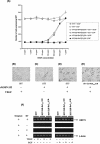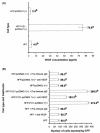Raf-induced vascular endothelial growth factor augments Kaposi's sarcoma-associated herpesvirus infection
- PMID: 15542692
- PMCID: PMC525017
- DOI: 10.1128/JVI.78.23.13381-13390.2004
Raf-induced vascular endothelial growth factor augments Kaposi's sarcoma-associated herpesvirus infection
Abstract
Recombinant green fluorescent protein encoding Kaposi's sarcoma-associated herpesvirus (rKSHV.152) infection of beta-estradiol stimulated human foreskin fibroblasts (HFF) or HFF/DeltaB-Raf([FF]):ER (expressing a weaker form of B-Raf) could be enhanced to levels comparable to that of HFF/DeltaB-Raf([DD]):ER cells by pretreating cells with soluble vascular endothelial growth factor (VEGF). Conversely, VEGF expression and infection efficiency typically observed in beta-estradiol stimulated HFF/DeltaB-Raf([DD]):ER cells could be lowered significantly by treating with VEGF small interfering RNA. In addition, we observed enhancement of the KSHV infection in HFF cells transfected with human VEGF(121). These results confirm the ability of Raf-induced VEGF to augment KSHV infection of cells.
Figures







References
-
- Akula, S. M., P. W. Ford, A. G. Whitman, K. E. Hamden, J. G. Shelton, and J. A. McCubrey. 2004. Raf promotes human herpesvirus-8 (HHV-8/KSHV) infection. Oncogene 23:5227-5241. - PubMed
-
- Akula, S. M., F. Z. Wang, J. Vieira, and B. Chandran. 2001. Human herpesvirus 8 (KSHV/KSHV) infection of target cells involves interaction with heparan sulfate. Virology 282:245-255. - PubMed
-
- Akula, S. M., N. P. Pramod, F. Z. Wang, and B. Chandran. 2002. Integrin α3β1 (CD 49c/29) is a cellular receptor for Kaposi's sarcoma-associated herpesvirus (KSHV/KSHV) entry into the target cells. Cell 108:407-419. - PubMed
-
- Aoki, Y., and G. Tosato. 1999. Role of vascular endothelial growth factor/vascular permeability factor in the pathogenesis of Kaposi's sarcoma-associated herpesvirus-infected primary effusion lymphomas. Blood 94:4247-4254. - PubMed
-
- Autiero, M., J. Waltenberger, D. Communi, A. Kranz, L. Moons, D. Lambrechts, J. Kroll, S. Plaisance, M. De Mol, F. Bono, S. Kliche, G. Fellbrich, K. Ballmer-Hofer, D. Maglione, U. Mayr-Beyrle, M. Dewerchin, S. Dombrowski, D. Stanimirovic, P. Van Hummelen, C. Dehio, D. J. Hicklin, G. Persico, J. M. Herbert, D. Communi, M. Shibuya, D. Collen, E. M. Conway, and P. Carmeliet. 2003. Role of PlGF in the intra- and intermolecular cross talk between the VEGF receptors Flt1 and Flk1. Nat. Med. 9:936-943. - PubMed
Publication types
MeSH terms
Substances
Grants and funding
LinkOut - more resources
Full Text Sources
Research Materials
Miscellaneous

